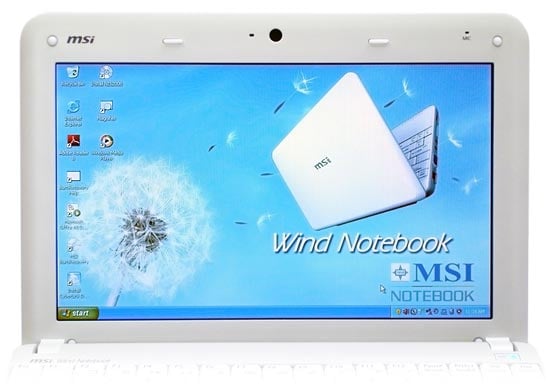MSI Wind U100 Netbook
Build Quality & Features

The Wind offers the standard arrangement of extra gadgets and connectivity. Integrated into the screen bezel is the ubiquitous webcam with accompanying microphone. The right side of the unit also has an unusually speedy 4-in-1 media card reader. The Wind offers 3 USB ports, two on the left and one on the right, as well as VGA-out and 10/100 ethernet. This is a pretty typical setup for a netbook although some newer models sport faster Gigabit ethernet ports which puts the Wind at a slight disadvantage. However since netbooks are portable machines, you're not likely to be relying on ethernet much anyway and the built-in 802.11 b/g/n wireless card will serve most users well.
The Wind has a single cooling fan located on the left side. This is a low-output blower style fan that helps air circulation within the chassis by bringing it up from vents along the bottom of the unit and expelling it out a vent on the left side. The fan is off most of the time and occasionally turns on to help with cooling as needed.
MSI Wind U100 Screen (click to enlarge)
The Wind U100 features a 10.2" LED backlit screen with the now standard netbook resolution of 1024x600. The screen has a matte finish with decent anti-reflective properties and the backlight is plenty bright. We had no problem using the Wind outdoors although direct sunlight on a sunny day will still be a problem.
Unsurprisingly for a netbook, the LCD panel used by the Wind is a TN unit of mid-range quality. It gets the job done but don't expect miracles. Like many netbooks, the viewing angle is noticeably poor. However the screen does offer decent brightness and good color. For single-user use from an intimate up-close sitting position, we found the screen rather pleasant. Overall we'd say the screen quality if on par with other mid-range netbooks we've tried in the past like the ASUS 1000 and the Lenovo S10.
MSI Wind U100 Keyboard & Touchpad (click to enlarge)
Like nearly all netbooks, the Wind features a somewhat miniaturized keyboard with a very compact layout. The primary letter and number keys are slightly smaller than those found on a typical 15.4" notebook but not by much. It was hard to notice the difference unless the Wind was placed side-by-side with a full-size notebook. The rest of the keys, however, have received very noticable shrink treatments. The F-keys and arrow keys have all been shrunken which is rather common, even on larger notebooks. Annoyingly some of the punctuation keys have also been shrunk to 3/4th width. This threw us off at first and took some getting used to. Overall the keyboard is fairly pleasant to type on. It didn't feel cramped although the layout took a few minutes to get the hang of. The keys have good tactile feedback and felt sturdy. The keyboard is also free from "mush" and "sag".
While the Wind's keyboard is quite good, we can't say the same about the touchpad. First off, it's tiny at only 2" by 1.7". While we can understand the touchpad couldn't be very tall due to space constraints, we wonder why MSI chose a square design. It would have helped immensely had the touchpad been wider. Another gripe is the design of the touchpad buttons. Instead of using two separate buttons, the Wind has a single rocker button. The bar rocks back and forth like a seesaw for left and right clicking. While this works relatively well for single clicks, it makes simultaneously pressing the left and right buttons at the same time nearly impossible.
To top off the list of gripes we have with the Wind's touchpad, it also uses a Sentilic unit, rather than the more popular Synaptic units used in most notebooks. Unlike Synaptic touchpads, Sentilic units, such as the one used by the Wind, cannot recognize finger gestures which means no finger-slide scrolling. Instead you need to continuously tap a corner of the touchpad to scroll. Sentilic touchpads are also significantly less configurable. While Synaptic touchpad drivers allows you to adjust just about every setting and feature of the touchpad, Sentilic units are much more limited. For instance, you can't change the sensitivity of the touchpad which would be less of an issue if the default wasn't so high. The touchpad would often register clicks when we simply hovered above the touchpad without touching it, or it would go into "click-and-drag" mode inadvertently after only a single "click". While it may be possible to eventually get used to the touchpad's sensitivity, this isn't something we should have to deal with.










